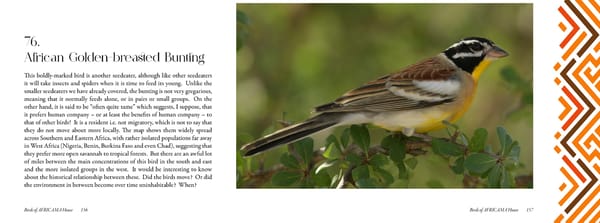76. African Golden-breasted Bunting This boldly-marked bird is another seedeater, although like other seedeaters it will take insects and spiders when it is time to feed its young. Unlike the smaller seedeaters we have already covered, the bunting is not very gregarious, meaning that it normally feeds alone, or in pairs or small groups. On the other hand, it is said to be “often quite tame” which suggests, I suppose, that it prefers human company – or at least the benefits of human company – to that of other birds! It is a resident i.e. not migratory, which is not to say that they do not move about more locally. The map shows them widely spread across Southern and Eastern Africa, with rather isolated populations far away in West Africa (Nigeria, Benin, Burkina Faso and even Chad), suggesting that they prefer more open savannah to tropical forests. But there are an awful lot of miles between the main concentrations of this bird in the south and east and the more isolated groups in the west. It would be interesting to know about the historical relationship between these. Did the birds move? Or did the environment in between become over time uninhabitable? When? Birds of AFRICAMA House 156 Birds of AFRICAMA House 157
 Birds of Africama 1 Page 78 Page 80
Birds of Africama 1 Page 78 Page 80